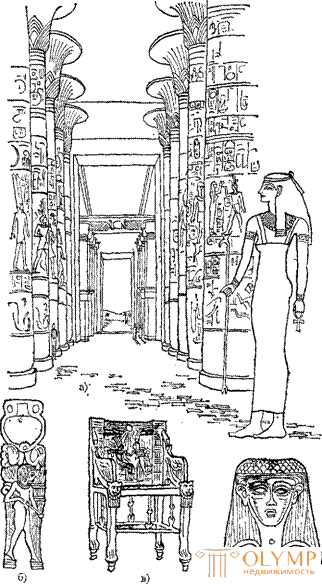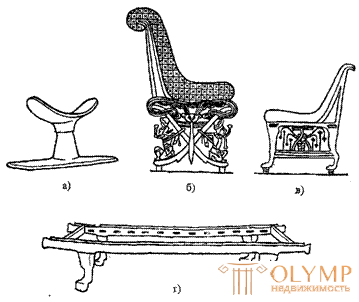
The history of ancient Egypt - one of the first slave-owning states - originates in the V millennium BC. and continues until the XII century. BC. - The time of the collapse of the New Kingdom. For Egypt, as well as for any eastern despotism, there is a sharp opposition between a relatively small number of exploiters and a huge number of exploited masses. Hence the duality of architecture and art of ancient Egypt. Egyptian architecture differed in sharp contrast between the heavy, eternally-designed monumental architecture for the pharaohs and the nobility, and a light residential for ordinary people, which was fragile.
By murals and bas-reliefs can basically restore the appearance of the dwelling of the ancient Egyptian. The ceiling was supported by carved wooden columns, painted walls, and sometimes decorated with faience inlays. Doorways were closed with sashes on vertical pins, and sometimes with mats or pieces of cloth. The interior decoration was complemented by bright fabrics and carpets.
In ancient Egypt, the stylistic unity of monuments of architecture, furniture, dishes, jewelry was determined by the desire to reflect in their images the idea of the eternal and unshakable power of the pharaoh (Fig. 1).
Egypt is the most ancient state, the furniture samples of which have survived to this day, thanks to the custom of leaving in burials things intended for the life of the deceased in the next kingdom. The atmospheric and climatic features of Egypt also played a well-known role — the buried objects found themselves in natural conservation.
When the tomb of Pharaoh Tutankha-mona was opened in 1922, many well-preserved pieces of furniture and applied art were discovered.
Ancient Egypt belongs to the honor of the invention of the actual furniture. For the first time in Egypt with the help of improved saws, tree trunks were cut into boards, which made it possible to obtain a constructive combination of elements of a furniture product. In Egypt, the first chair appeared with a back, which acquires the constructive shape that became the basis for all subsequent forms of chairs. Originally in ancient Egypt there was a custom to sit on the ground. Then there were low benches and chairs, and then the rich Egyptians - ceremonial chairs. The Egyptians first introduced the form raised from the floor of the bed.

Fig. 1. The stylistic unity of the architectural and subject environment of Ancient Egypt: a is a fragment of the interior of the temple of Amon at Karnak, b is a toilet spoon, c is the golden throne of Pharaoh Tutankhamun, d is a detail of the chair

Fig. 2. Wood processing in Ancient Egypt (from ancient painting)
The Egyptians widely used wood (cedar, si-cimora, yew, olive, ebony), bringing it from neighboring countries - Lebanon, Phenicia and Nubia. Furniture made almost entirely of wood. They owned a large set of tools - axes, saws, adzes, drills (Fig. 2), but they were not familiar with the plane, so the surface was leveled with a knife or adze, and then cleaned with sandstone and pumice stone.
Slaves and free artisans were engaged in carpentry craft; later more expensive products were made by special craftsmen. The father gave the secrets of the craft to his son, which explains the stability of the furniture forms.
They made various types of furniture (fig. 3): chests, caskets, cabinets, beds, stools, chairs, armchairs, tables. Instead of a pillow, we used head stands (Fig. 3, a). It is cooler to lie on it, and at the same time a lush hairstyle was preserved. The furniture of the palaces differed from the furniture of the dwelling of the common people not so much in design as in the value of the materials, the wealth and elegance of the decorations. The ornament that decorated the furniture consisted of elements (sun disk, scarab, snake, kite, lotus, palm, papyrus), which had a symbolic meaning. In the decoration of furniture, the Egyptians liked to use, without mixing, the bright colors of red, yellow, black, brown, blue, green and white. For example, the throne of Tutankhamen (Fig. 1, c) is a wooden armchair sheathed with gold leaf against which inlays of faience, colored glass and stones sparkle. The symbols of images of animal figures are characteristic. The armrests are openwork and made in the form of winged snakes supporting the emblem of the pharaoh The front legs are completed with lion heads of chased gold. Soft cushions or mattresses that covered the seat, and sometimes the backrest, were placed on the armchairs and chairs.

Fig. 3. Furniture of Ancient Egypt: a - ebony head bench, b - throne, c - chair with supports in the form of animal paws, d - bed frame
Types of chairs and chairs are varied (Fig. 3, b, c). The main scheme is a back with a blade, complex profiles of legs, ending with sculpted lion paws, progresses. The stools were made on three legs with a saddle seat made of stretched fabric. A folding stool with X-shaped supports was distributed. Reliability of the stool on vertical supports was provided by connecting the racks and the frame with a whole system of horizontal ties and struts, which sometimes took a pictorial form: lotus flowers, stalks, and bird figures. The shapes of the legs are various - square, round, complexly designed, diverging to the outside, etc.
Clothes, utensils and food supplies were stored in portable chests and caskets. Frame caskets were made in the shape of a parallelepiped on four legs, supplied with gable or semi-cylindrical covers, decorated with curly friezes, ornamental compositions, including framed plot marks. They also used painting, ivory inlay.
Tables are varied in design and purpose; low, high, portable and stationary, workers, for a meal, stands for vases, decorative, small tables set on an openwork elevation, very low for board games, dining on a column-shaped support for one or two people with a table top with raised edges.
Egyptian civilization created the shape of the bed - bed (Fig. 3, d). The wooden frame was installed on four pillars, which usually had the shape of the legs of a walking animal.
At the foot there was a rectangular ornamented plane. On the frame, ropes or belts were stretched, forming an elastic flooring in the form of continuous weaving or netting.
In an effort to hide the defects in the assembly, the surface of the furniture was first covered with a thick layer of paint - putty, and then with white or colored paint.
Widely used in the dwellings of Egyptians utensils, woven from palm fibers, baskets with a lid, boxes, mats.
An example of the products of ancient Egyptian carpentry technology are sarcophagi. Most often they were made from sycamore wood. Outlines they resembled the outlines of the human body. Curved side walls were made with an ax and a knife. The cover was decorated with reliefs in the form of a human face, and sometimes hands were also depicted.
The art of Egypt already in antiquity had a great influence on the artistic culture of other nations. Elements of Egyptian ornaments are found in ancient Roman furniture. After Napoleon's campaign in Egypt (1798), Egyptian art once again attracted attention. The influence of the Egyptian forms found a vivid expression in the Empire style that developed after 1800, especially in the French furniture of this style.
Что бы оставить комментарий войдите
Комментарии (0)